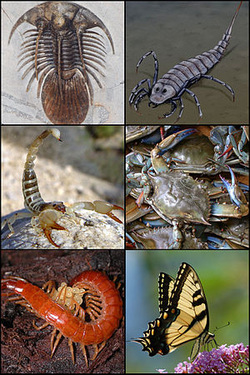Animal Resource Page
The Arthropods: Characteristics of Phylum Arthropoda
Text taken from: Once Upon a Life Science Book © 2010 NSTA
The Big Question: What features make arthropods unique? If you were a fly, you could flap your wings more than 100 times in one second. If you were a spider, you would hear with tiny hairs on your legs. If you were a lobster, you would grow a whole new skeleton several times a year. Flies, spiders, and lobsters are classified as arthropods. This phylum, or animal group also includes all of the insects, crabs, ticks, centipedes, and scorpions. They have skeletons outside their bodies. Their bodies are divided into segments. They have legs, antenna, and other parts that bend in several places. Finally, they have highly developed organs to sense their environments. Arthropod Skeletons When you think of a skeleton, you probably think of bones. However, not all skeletons are made of bones. An arthropod has a tough, hard covering on the outside of its body. This covering is called an exoskeleton, which means skeleton on the outside. Any skeleton has three main functions: it gives the body shape, protects internal organs, and provides structure for muscles to attach. For example, a dog's bones determine its shape. The rib bones protect the dog's heart and lungs. When a dog runs, its leg muscles pull on the leg bones to cause movement. The exoskeleton to a dragonfly serves the same functions. It gives the dragonfly its shape. It protects the soft body inside. The muscles in the dragonfly are anchored to the hard outer covering. Those muscles move the wings and legs to allow the insect to fly and walk. For their size, exoskeletons are much stronger than bones. This means an insect can fall from a great height without breaking anything. However, an insect's exoskeleton cannot grow once it is formed. This means that insects must replace their outer covering, or molt, as they get bigger. Animals that do not have bones inside, including arthropods, are called invertebrates. Technically the word invertebrate means without a backbone because the bones in the back are called vertebrae. However, the word invertebrate is used to indicate that an animal has no bones at all. Segmented Bodies Arthropod bodies are divided into sections, called segments. In some arthropods, such as centipedes, you can see the segments clearly on the outside. In a centipede, almost every segment has a pair of legs. In other arthropods, the segments of an insect are grouped into three regions: the head, thorax, and abdomen. All six legs of an insect connect to the thorax. Jointed Attachments The walking legs of a centipede or insect are just one type of attachment that can connect to the body of an arthropod. Arthropods may also have swimming legs, antennae, claws, or pincers. Many arthropods also have attachments near their mouth to help with slicing or chewing food. All of these attachments are called appendages. The appendages in an arthropod have joints that allow them to bend, much like the arms and legs of a person. The name of the phylum reflects this feature. The word Arthropoda means jointed foot. Highly Developed Sensory Organs Many arthropods have antennae on their heads. Antennae are appendages that contain sense organs. For instance, the antennae of a lobster contain organs for tasting, feeling, and smelling. Arthropods also have organs for seeing and hearing. The ability to see differs among arthropods. Spiders have eight simple eyes that are primarily used to sense motion. However, many insects have compound eyes that allow them to see color, shape, and movement in all directions at the same time. For hearing arthropods have organs to detect vibrations. Some arthropods have very sensitive hairs that do this task. Others, such as the grasshopper, have a flexible membrane that works a lot like the ear drum in a human ear. A Recipe for Success The arthropods are a diverse group of animals. Their exoskeletons, segmented bodies, jointed appendages, and highly developed sense organs have allowed them to adapt to a wide range of environments. In fact there are more species of arthropods than of all other animals combined. |
Animal Documents
Pictures, Links, & Videos
Use the pictures, links, and videos on this side to help you learn more about bacteria. If you find other resources that we can use save them in Diigo and I'll add them to our list.
WORM DISSECTION LINKS Adventures of Herman the Worm Virtual Worm Tour Understand: The Animal Kingdom Overview Invertebrates Vertebrates San Diego Zoo Animals Critter Catalog-Michigan A to Z List of Animals Videos: Moby and Annie on Animals Interactives: A Touch of Class- Game on Classifying | ||||||||||||
